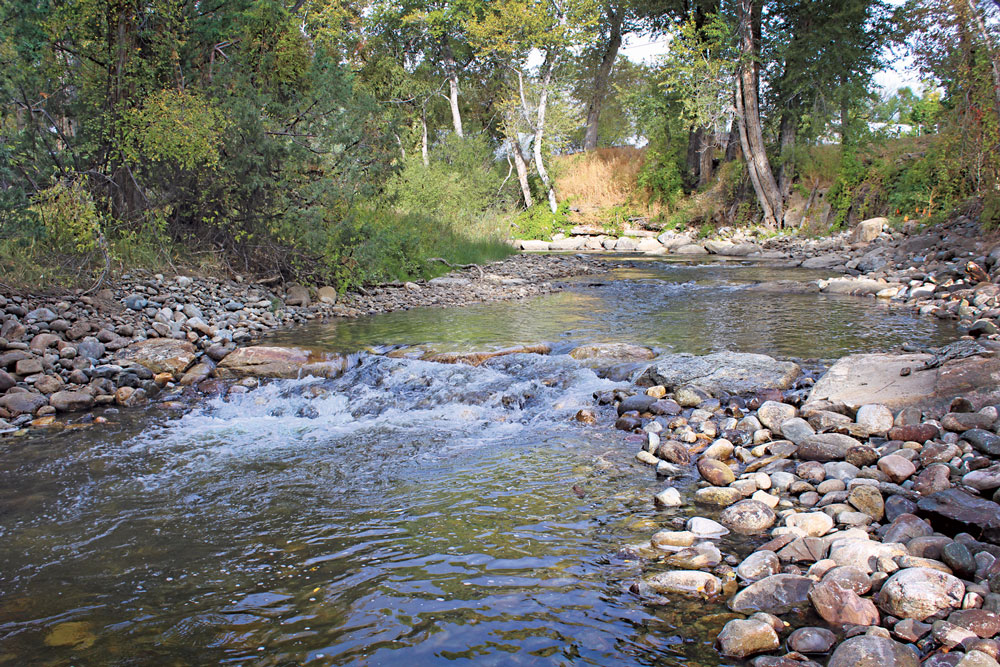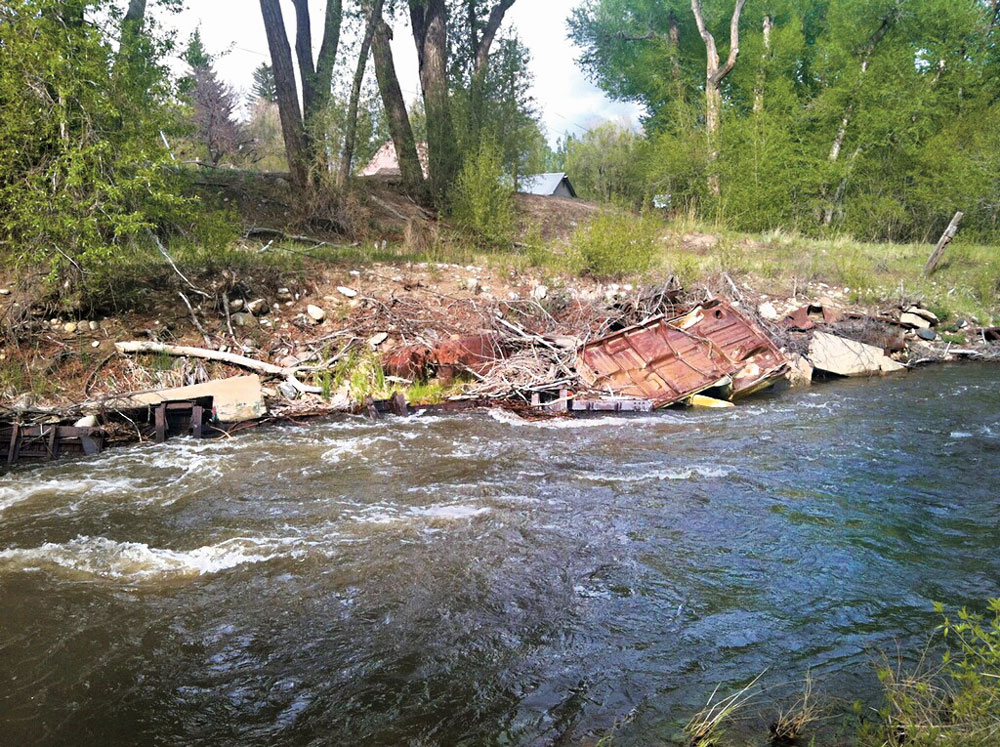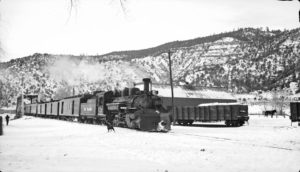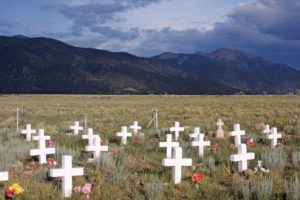
By Kim Marquis
Shortly after moving to Salida in 2008, Fred Klein and his wife, Vicki, purchased a lush triangle of land fronting the South Arkansas River in Poncha Springs.
The property became a getaway for the couple, where they remodeled a one-room cabin and relaxed among soaring cottonwoods, listening to the river rush by. After decades living in prickly, drought-ridden Santa Fe – where water is so scarce they’d put a bucket in the shower to water outside plants – their acreage on the “Little Ark” seemed like a romantic dream come true.
On a sunny June morning during that first year, Fred was picking up fallen cottonwood branches on the property as a tractor approached the far bank across the river. He stopped his work to watch as all four tires on the big machine crunched over the bank and into the riverbed, then turned upstream. The front-end loader splashed into the water and the tractor lunged forward with its blade scraping the riverbed, scooping up rocks and everything else on the way.

As a lifelong fly fisherman who has been standing in rivers since he was 6 years old, Fred was horrified.
“All the fish habitat, the aquatic plant and insect environment, was being decimated over a stretch of several hundred feet there in front of me,” he said. “There was absolutely no regard for the ecology at all.”
He waved the driver down, finding out that the tractor was used every year in the same way, to rebuild a temporary diversion dam that delivers water to an irrigation ditch.
Fred decided to act. He hired a Front Range hydrologist and went to the Army Corps of Engineers for a permit to improve the diversion and restore the river. The permit took years but in the meantime, he gained the support of the irrigation ditch owners to try something new.
“I knew it was worth their considerable apprehension, that this new kid on the block wanted to mess with their program,” he said. “I think they thought I was more trouble than I was worth. But they tolerated it and let me give it a shot.”
He brought in about 300 tons of river boulders and moved fallen cottonwood trunks on his property, placing them in the river to create a natural diversion that delivers the Salida irrigators their water without the use of a tractor. The restoration project also created new holds for fish, where they hang out in soft water that is oxygenated while feeding.
Fred knew on that June day that there were brown trout in the Little Ark. He had caught small fish, mostly under a foot long. But today, the reach on his property holds more fish that grow to 18 inches and larger.
His project spurred the interest of neighbors, who worked with the Land Trust of the Upper Arkansas to replicate river restoration upstream.
[InContentAdTwo]
The Land Trust found grant funding to support work on an additional 1,200 feet of the river and partnered with the Collegiate Peaks Chapter of Trout Unlimited and National Trout Unlimited to connect river improvements all the way up to the U.S. Hwy. 285 bridge in Poncha Springs.
Now the Land Trust and its partners are working with landowners on another reach of the South Arkansas north of the bridge. A third location will restore a section downstream in Salida. The larger goal is to restore the entire river from Monarch Pass to where it empties into the Gold Medal Trout Waters of the Arkansas.
Fred Klein had his reasons for restoring a small reach of the river. He said he hoped the initial project would serve as a model for other sections of the river.The South Arkansas is Chaffee County’s second-largest waterway. It is vital to the people, wildlife and agricultural operations in the Upper Arkansas Valley. It flows through two towns, 174 private properties and the San Isabel National Forest. Yet historical human uses of its water have put pressure on the river. Its flows have been channelized, its bends straightened, its banks eroded and its wetland habitat degraded.
The Land Trust’s wider vision is to improve the South Arkansas River’s water quality, wildlife resources and watershed health. The work takes private landowner participation and the support of the entire community to appreciate the benefits.
“Healthy water is important not only for the fishery, but for everyone who lives within the watershed,” Land Trust Executive Director Andrew Mackie said. “Our agricultural systems, natural systems and even our human systems – our towns – depend on good, healthy water supplies.”
The organization completed a watershed assessment in 2010, determining that the river’s headwaters from Monarch Pass to Maysville are fairly healthy, but natural systems from the valley floor through Salida have been heavily impacted.
The river does not contain heavy metals, but the water quality is degraded by sedimentation caused by erosion, the report found.
Erosion is often caused by human changes to the river and its banks, from removing vegetation to adding hardened materials such as concrete and even car bodies. This was done in past years to try to shore up certain banks, but Mackie said those efforts usually create larger sedimentation problems downstream, as the force of the river is diverted to new locations.
By removing these foreign materials and replacing them with natural rocks and vegetation, the river is returned to its natural flow to reduce erosion and at the same time, create better habitat for fish.
Restoration efforts include working with water rights holders to make sure they get the water they are entitled to while reducing or eliminating annual maintenance, Mackie said.
Purchasing and planting new vegetation to shore up river banks is costly and requires the hard work of many volunteers, but it is an important part of the restoration.
“If you have a nice, healthy riparian buffer, pollutants like car oil, yard fertilizers, trash and other runoff is captured in soil and plant roots before entering the water source,” Mackie said.
River restoration in Salida will occur on property owned by the Southwest Conservation Corps, a nonprofit organization that operates conservation service programs for youth and adults in southern Colorado and northern New Mexico.
The Land Trust will again partner with the Collegiate Peaks Chapter of Trout Unlimited and National Trout Unlimited, as well as the Greater Arkansas River Nature Association, to improve an 800-foot stretch of river in Salida and create the South Arkansas River Ecological Learning Center, where students will explore topics such as water quality, river stewardship, ecological processes, water cycles and aquatic food chains.
“Eventually, kids will be able to come down and learn how the river functions, how to determine whether the river is healthy, and compare their studies to other sites,” Mackie said.
The Land Trust is raising $40,000 this year for river restoration on the Salida site and $25,000 for the stretch near Poncha Springs, where the organization holds a conservation easement that protects the property from future development.
The Land Trust has helped protect more than 10,000 acres in the region for their important open space values, scenic views, agricultural uses and wildlife benefits.
“Restoring rivers is an important part of what we do, because protecting water resources is just as important as preserving the land for many generations to come,” Mackie said. g
Kim Marquis does writing and research from her home in Buena Vista, but only when it’s raining or dark outside, because otherwise she is occupied with non-lucrative activities involving ropes and carabiners, metal-edged wooden planks, highly inflatable objects, and/or fishing line.



